
A loudspeaker is an electroacoustic transducer that converts an electrical audio signal into a corresponding sound. A speaker system, also often simply referred to as a speaker or loudspeaker, comprises one or more such speaker drivers, an enclosure, and electrical connections possibly including a crossover network. The speaker driver can be viewed as a linear motor attached to a diaphragm which couples that motor's movement to motion of air, that is, sound. An audio signal, typically from a microphone, recording, or radio broadcast, is amplified electronically to a power level capable of driving that motor in order to reproduce the sound corresponding to the original unamplified electronic signal. This is thus the opposite function to the microphone; indeed the dynamic speaker driver, by far the most common type, is a linear motor in the same basic configuration as the dynamic microphone which uses such a motor in reverse, as a generator.

Audio crossovers are a type of electronic filter circuitry that splits an audio signal into two or more frequency ranges, so that the signals can be sent to loudspeaker drivers that are designed to operate within different frequency ranges. The crossover filters can be either active or passive. They are often described as two-way or three-way, which indicate, respectively, that the crossover splits a given signal into two frequency ranges or three frequency ranges. Crossovers are used in loudspeaker cabinets, power amplifiers in consumer electronics and pro audio and musical instrument amplifier products. For the latter two markets, crossovers are used in bass amplifiers, keyboard amplifiers, bass and keyboard speaker enclosures and sound reinforcement system equipment.
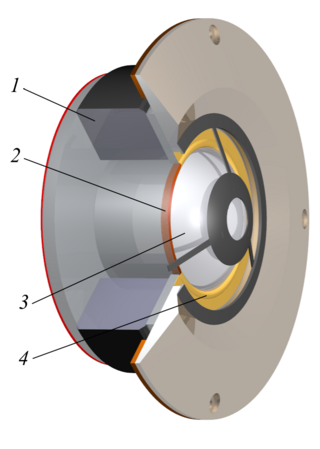
A tweeter or treble speaker is a special type of loudspeaker that is designed to produce high audio frequencies, typically deliver high frequencies up to 100 kHz. The name is derived from the high pitched sounds made by some birds (tweets), especially in contrast to the low woofs made by many dogs, after which low-frequency drivers are named (woofers).
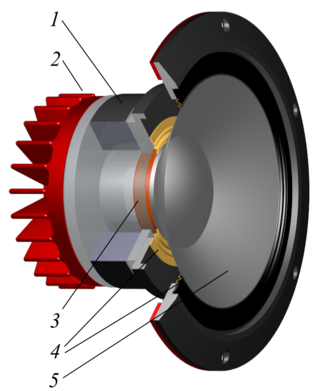
A mid-range speaker is a loudspeaker driver that reproduces sound in the frequency range from 250 to 2000 Hz.
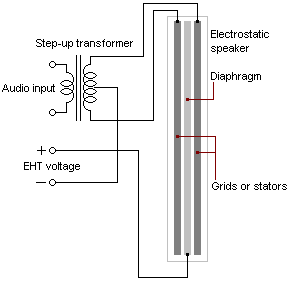
An electrostatic loudspeaker (ESL) is a loudspeaker design in which sound is generated by the force exerted on a membrane suspended in an electrostatic field.

A horn loudspeaker is a loudspeaker or loudspeaker element which uses an acoustic horn to increase the overall efficiency of the driving element(s). A common form (right) consists of a compression driver which produces sound waves with a small metal diaphragm vibrated by an electromagnet, attached to a horn, a flaring duct to conduct the sound waves to the open air. Another type is a woofer driver mounted in a loudspeaker enclosure which is divided by internal partitions to form a zigzag flaring duct which functions as a horn; this type is called a folded horn speaker. The horn serves to improve the coupling efficiency between the speaker driver and the air. The horn can be thought of as an "acoustic transformer" that provides impedance matching between the relatively dense diaphragm material and the less-dense air. The result is greater acoustic output power from a given driver.
Klipsch Audio Technologies is an American loudspeaker company based in Indianapolis, Indiana. Founded in Hope, Arkansas, in 1946 as 'Klipsch and Associates' by Paul W. Klipsch, the company produces loudspeaker drivers and enclosures, as well as complete loudspeakers for high-end, high-fidelity sound systems, public address applications, and personal computers.
Celestion is a British designer and exporter of professional loudspeakers.

Rudolph Thomas Bozak (1910–1982) was an audio electronics and acoustics designer and engineer in the field of sound reproduction. His parents were Bohemian Czech immigrants; Rudy was born in Uniontown, Pennsylvania. Bozak studied at Milwaukee School of Engineering; in 1981, the school awarded him an honorary doctorate in engineering. Bozak married Lillian Gilleski; the two had three daughters: Lillian, Mary and Barbara.
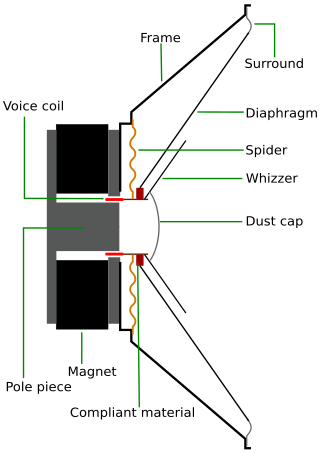
A full-range loudspeaker drive unit is defined as a driver which reproduces as much of the audible frequency range as possible, within the limitations imposed by the physical constraints of a specific design. The frequency range of these drivers is maximized through the use of a whizzer cone and other means. Most single driver systems, such as those in radios, or small computer speaker designs, cannot reproduce all of the audible frequencies or the entire audible audio range.

Acoustic Research was a Cambridge, Massachusetts-based company that manufactured high-end audio equipment. The brand is now owned by VOXX. Acoustic Research was known for the AR-3 series of speaker systems, which used the 12 in (300 mm) acoustic suspension woofer of the AR-1 with newly designed dome mid-range speaker and high-frequency drivers. AR's line of acoustic suspension speakers were the first loudspeakers with relatively flat response, extended bass, wide dispersion, small size, and reasonable cost. The AR Turntable remains a highly sought vinyl record player.

Studio monitors are loudspeakers in speaker enclosures specifically designed for professional audio production applications, such as recording studios, filmmaking, television studios, radio studios and project or home studios, where accurate audio reproduction is crucial. Among audio engineers, the term monitor implies that the speaker is designed to produce relatively flat (linear) phase and frequency responses. In other words, it exhibits minimal emphasis or de-emphasis of particular frequencies, the loudspeaker gives an accurate reproduction of the tonal qualities of the source audio, and there will be no relative phase shift of particular frequencies—meaning no distortion in sound-stage perspective for stereo recordings. Beyond stereo sound-stage requirements, a linear phase response helps impulse response remain true to source without encountering "smearing". An unqualified reference to a monitor often refers to a near-field design. This is a speaker small enough to sit on a stand or desk in proximity to the listener, so that most of the sound that the listener hears is coming directly from the speaker, rather than reflecting off walls and ceilings. Monitor speakers may include more than one type of driver or, for monitoring low-frequency sounds, such as bass drum, additional subwoofer cabinets may be used.

First produced in 1982, the Yamaha NS-2000 is an improved version of the older NS-1000 speaker that was first made in the early to mid-1970s. Like the NS-1000, it is a 3-way acoustic suspension speaker system with a beryllium-dome midrange and tweeter. However, the woofer of the NS-2000 was entirely new, made of pure carbon fiber instead of paper. The cabinet is also improved and is larger and heavier than that of the NS-1000.

HD77 is a model name of Marantz 4-way high-fidelity loudspeakers which were produced during the mid-1970s. They were bass reflex speakers, but came with a cylindrical piece of foam which fit into the bass-reflex port of the enclosure if the listener preferred the more accurate bass response provided by airtight speaker boxes. However, they were not fully airtight this way, but rather what is known as aperiodic. They were designed by former JBL Engineer Edmond May. The foam plug in port was in fact a "closed-cell" type which did in fact seal cabinet completely. How it worked was it was cut slightly larger than opening and when inserted, you turned the retainer screw and it would tighten and compress the plug, thereby sealing the cabinet to make the loudspeaker a "suspension" type. The controls on baffle are resistive potentiometers, which changed the response curve of corresponding driver from soft to bright, giving great versatility to adapt within almost any listening environment.
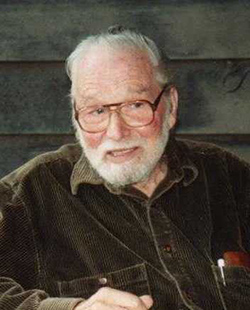
Edgar Marion Villchur was an American inventor, educator, and writer widely known for his 1954 invention of the acoustic suspension loudspeaker which revolutionized the field of high-fidelity equipment. A speaker Villchur developed, the AR-3, is exhibited at The Smithsonian Institution's Information Age Exhibit in Washington, DC.

An electrodynamic speaker driver, often called simply a speaker driver when the type is implicit, is an individual transducer that converts an electrical audio signal to sound waves. While the term is sometimes used interchangeably with the term speaker (loudspeaker), it is usually applied to specialized transducers which reproduce only a portion of the audible frequency range. For high fidelity reproduction of sound, multiple loudspeakers are often mounted in the same enclosure, each reproducing a different part of the audible frequency range. In this case the individual speakers are referred to as drivers and the entire unit is called a loudspeaker. Drivers made for reproducing high audio frequencies are called tweeters, those for middle frequencies are called mid-range drivers, and those for low frequencies are called woofers, while those for very low bass range are subwoofers. Less common types of drivers are supertweeters and rotary woofers.
KEF is a British company specialising in the design and production of a range of high-end audio products, including HiFi speakers, subwoofers, architecture speakers, wireless speakers, and headphones. It was founded in Maidstone, Kent in 1961 by a BBC engineer named Raymond Cooke (1925–1995).
Loudspeaker time-alignment usually simply referred to as "time-alignment" or "Time-Align" is a term applied in loudspeaker systems which use multiple drivers to cover a wide audio range. It involves delaying the sound emanating from one or more drivers to correct the transient response, improve accuracy and, in non-coaxial drivers, improve the directivity or lobe tilting at the crossover frequencies. It employs adjusting the front-to back spacing of the individual drivers so that the sound output is truly simultaneous.

Veritone Minimum Phase Speakers, or VMPS, was a loudspeaker manufacturer founded in 1977 by speaker designer Brian Cheney. Many VMPS speakers received favorable reviews from audio critics, such as the RM40, which was awarded Best of CES in the High-End Audio category in 2002. VMPS was in operation for over 35 years, from January 1977 to December 2012, when it closed soon after the death of company owner Brian Cheney on December 7, 2012.
Monitor Audio is a British company that specialises in designing and manufacturing loudspeakers and sound systems.















